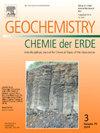坦桑尼亚西南部新元古代铝质a型花岗岩的地球化学和U-Pb年代学:对南部非洲Tonian地球动力学演化的启示
IF 2.9
3区 地球科学
Q2 GEOCHEMISTRY & GEOPHYSICS
引用次数: 0
摘要
这项研究提供了关于Litembo花岗岩的新见解,Litembo花岗岩是位于东非坦桑尼亚南部乌本甸带以南的一个30公里宽的岩体。利用全岩地球化学、U-Pb锆石年代学和Rb-Sr同位素系统确定了其地球化学组成、年龄和成因,为区域地质和地球动力学背景提供了依据。花岗岩为铝质、过铝质、铁质和钙碱性花岗岩,具有高浓度的Sr、Rb、Ba、高场强元素(HFSE,如Zr、Y、Nb和Ta)和高Ga/Al比值。花岗岩总稀土元素(REE)含量在335 ~ 693 ppm之间,呈分异分布(La/Yb)CN = 9.40 ~ 15.41),呈负Eu异常(Eu/Eu*,平均值= 0.87)。原始地幔归一化柱面图显示Ti、Sr、P、Y和Cs为负模式,同时大离子亲石元素(LILE,如Rb和Ba)富集。岩石的地球化学特征与造山(a型)花岗岩相似,暗示在伸展构造作用下,立腾堡花岗岩由深源熔体形成,涉及斜长石、石榴石、角闪孔和/或复杂的分异过程。最初的87Sr/86Sr比值(~ 0.7113)表明演化的地壳起源,Rb-Sr的不精确年龄约为658±20 Ma。激光烧蚀ICP-MS U-Pb锆石年龄分别为737.1±2.9 Ma和730.1±3.0 Ma,结晶年龄介于730 ~ 740 Ma之间,Rb和Sr在660 Ma左右发生热扩散。这些年龄和成分特征与非洲南部的托尼亚板块内(碱性和碳酸盐岩岩浆作用)一致,并支持与罗迪尼亚分裂有关的热事件,在莫桑比克带发育之前。本文章由计算机程序翻译,如有差异,请以英文原文为准。
Geochemistry and U-Pb geochronology of the Neoproterozoic aluminous A-type granite in the south-western Tanzania: Implications to the Tonian geodynamic evolution of Southern Africa
This study presents new insights on the Litembo granite, a 30 km wide pluton located south of the Ubendian Belt in the southern Tanzania, East Africa. Whole-rock geochemistry, U-Pb zircon geochronology, and the Rb-Sr isotope system were used to determine its geochemical composition, age, and origin, contributing to regional geological and geodynamic context. The granite is metaluminous to peraluminous, ferroan, and calc-alkalic with high concentrations of Sr, Rb, Ba, High Field Strength Elements (HFSE; e.g., Zr, Y, Nb, and Ta), and high Ga/Al ratios. The total Rare Earth Element (REE) concentrations of the granite range from 335 to 693 ppm, showing fractionated REE patterns in the chondrite-normalized spider diagram ((La/Yb)CN = 9.40–15.41) and a negative Eu anomaly (Eu/Eu*; mean = 0.87). Primitive mantle-normalized spidegrams reveal negative patterns for Ti, Sr, P, Y, and Cs, along with enrichment in Large Ion Lithophile Elements (LILE; e.g. Rb and Ba). Geochemical features of the rock are akin to anorogenic (A-type) granites, implying formation of Litembo granite from a deep source melt, involving plagioclase, garnet, and amphibole and/or complex differentiation processes, under extensional tectonics. An initial 87Sr/86Sr ratio (∼0.7113) suggests evolved crustal origins, with a Rb–Sr imprecise age of about 658 ± 20 Ma. Laser ablation ICP-MS U-Pb zircon dating yields crystallisation ages of 737.1 ± 2.9 Ma and 730.1 ± 3.0 Ma, indicating emplacement between 730 and 740 Ma, followed thermal diffusion of Rb and Sr in the rock at about 660 Ma. These ages and compositional features align with the Tonian intraplate (alkaline and carbonatite magmatism) in southern Africa and support for a thermal event linked to Rodinia's breakup, preceding development of the Mozambique Belt.
求助全文
通过发布文献求助,成功后即可免费获取论文全文。
去求助
来源期刊

Chemie Der Erde-Geochemistry
地学-地球化学与地球物理
CiteScore
7.10
自引率
0.00%
发文量
40
审稿时长
3.0 months
期刊介绍:
GEOCHEMISTRY was founded as Chemie der Erde 1914 in Jena, and, hence, is one of the oldest journals for geochemistry-related topics.
GEOCHEMISTRY (formerly Chemie der Erde / Geochemistry) publishes original research papers, short communications, reviews of selected topics, and high-class invited review articles addressed at broad geosciences audience. Publications dealing with interdisciplinary questions are particularly welcome. Young scientists are especially encouraged to submit their work. Contributions will be published exclusively in English. The journal, through very personalized consultation and its worldwide distribution, offers entry into the world of international scientific communication, and promotes interdisciplinary discussion on chemical problems in a broad spectrum of geosciences.
The following topics are covered by the expertise of the members of the editorial board (see below):
-cosmochemistry, meteoritics-
igneous, metamorphic, and sedimentary petrology-
volcanology-
low & high temperature geochemistry-
experimental - theoretical - field related studies-
mineralogy - crystallography-
environmental geosciences-
archaeometry
 求助内容:
求助内容: 应助结果提醒方式:
应助结果提醒方式:


